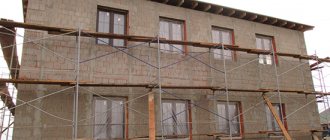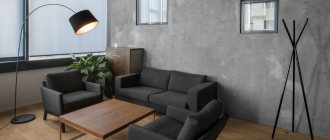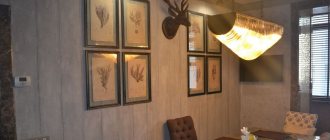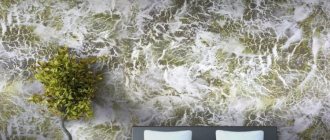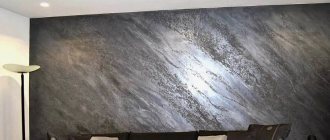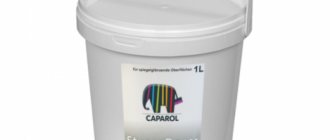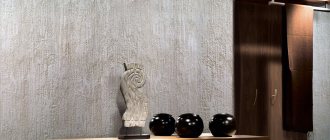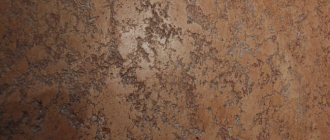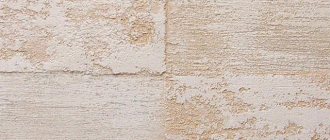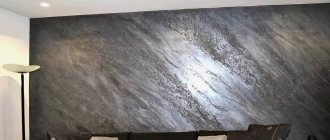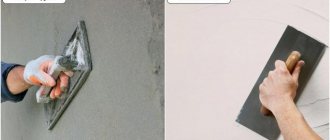Orange peel decorative plaster. Plastering with an “orange peel” effect
Today's:
- How to cover a refrigerator with your own hands. How to select and apply film
- Is it possible to lay tiles on waterproofing? Lay tiles for waterproofing
- Calculation of a canopy from a profile pipe online calculator. Calculation and drawing of the canopy
- Little black worms in the bathroom. Insects in the bathroom: photos and names
- How to cover the subfloor. What is better not to lay on the subfloor?
- How much money will it take to build a house? How much money does it take to build a house?
- How to remove old chipboard flooring. If you do not remove old paint from a wooden floor and lay chipboard on it
- Orange peel decorative plaster. Plastering with an “orange peel” effect
- Video master class
- How to apply decorative plaster with a trowel. Preparing the walls
- Decorative plaster Rainbow-35 DECOR GRANIT Color Concert (24) Piano black
- Bark beetle plaster “Bark beetle” plaster: characteristics and application features
- Features of the composition
- Types and characteristics
- Video decorative plaster Kratzputz (Cellulite)
How to apply decorative plaster with a trowel. Preparing the walls
Decorative plaster can be applied to any prepared surface:
When starting the work process, you need to carefully prepare the walls. The surface must be clean, dry, dust-free. All traces of the previous finishing are removed, cracks and irregularities must be puttied.
If the finishing is planned on brickwork, wooden walls or other uneven bases, then such surfaces must first be leveled - plastered or covered with sheets of gypsum plasterboard or chipboard. Large defects are hidden with plaster, small ones are covered with putty.
Before plastering, the walls are primed. The primer will ensure good adhesion of the decorative material to the walls. It is worth choosing alkyd or acrylic compositions of deep penetration. For wet rooms, an antiseptic primer is selected to protect the walls from the formation of fungi and mold.
To prepare walls made of smooth materials such as chipboard and plasterboard, adhesive compounds with quartz sand are needed. Sand will add roughness and improve the adhesion of the coating and the base. Adhesive quartz primer can be selected from the following brands: Bayramix Astar, DALI-Decor Quartz Primer, Alpina Expert, Betonokontakt.
If decorative plaster has already been applied to the walls, you can apply a new layer of material to it to update the interior. To do this, it is not necessary to get rid of the previous finish. It is enough to treat the surface with an adhesive primer, which ensures reliable and strong adhesion of the materials.
Reinforcement with fiberglass mesh. Some bases require reinforcement before decorative work. For example, when creating a wet facade, mineral wool or expanded polystyrene is covered with a layer of plaster with a fiberglass mesh. This is the base leveling layer. When finishing plastering, the mixture is applied in a thin layer of 2-5 mm; at this stage, fiberglass is not needed.
Introduction to the article
Decorating walls with decorative plaster gives a wide range of imagination to the master, and, at the same time, it is a low-cost way of transforming any room. The material has many advantages over other wall decorations:
- The ease of application makes it possible for even a poorly trained person with no experience in construction to easily master this art.
- This plaster has sufficient strength to withstand high humidity, temperature changes and mechanical stress. It does not lose its original color and freshness.
- Thanks to its components, textured plaster has a high aesthetic value. Selling companies offer numerous catalogs for choosing finishes, and the color range has practically no boundaries. Many types have inclusions that imitate sand, marble chips, orange peel and other textures.
- The ability to form fantastic reliefs is provided by the amazing plasticity of the material.
- The surfaces of plastered walls are easily cleaned of various contaminants.
External decorative plaster. Features of mineral plaster for facades
The composition of mineral plaster includes slaked lime, Portland cement, stone chips, colored clay, additional elements that increase the performance characteristics of the finished surface and components responsible for the texture of the finished facade. To increase resistance to fungus and mold, the mixture may contain additional fillers.
Cement plaster for facades forms a durable, non-flammable coating with a high level of thermal insulation properties.
The mixture is available in ready-made packages in the form of a powder, which must be diluted with a certain amount of water to obtain the finished solution. It can be applied to any type of surface. Before facing the walls, it is necessary to install a mesh under the facade plaster, which will level the surface, create additional adhesion of the plaster to the base and reduce the risk of cracks.
Cement plaster for exterior use creates a durable “breathable” decorative coating that does not smolder, does not burn, and does not emit toxic substances when heated. The suitability of the composition for work is no more than 90 minutes. After complete drying, a durable non-flammable coating with sound and heat insulation properties is formed on the wall surface. The decorative effect of the finishing material is provided by colored additives and granules.
On a note! Due to its low vibration resistance, mineral plaster should not be used for buildings located near railways and in areas with increased seismic activity.
Mineral plaster can withstand temperature fluctuations from -30 to +45ºС. without losing its performance properties. The service life of such coating is at least 15 years.
To give a more aesthetic appearance to a cement plaster coating, you can use façade paint for exterior use.
The color range of cement plaster is very limited, which reduces its decorative value. The finished surface of cement plaster can be painted in any color, thereby creating a more aesthetic appearance of the building.
Today, Knauf mineral facade plasters from the Diamant line, which have increased moisture-repellent properties and resistance to aggressive weather conditions, are very popular. Using a mixture of Diamant-240, you can obtain a textured “bark beetle” surface, and Diamant-260 forms a rough veneer, which is called a “fur coat.” The price of a 25 kg package is about 900 rubles.
Another equally popular option is Bolars mineral facade plaster, which can be purchased at a price of 700 rubles. Having a self-leveling structure, thanks to the modifying additives included in its composition, it creates a perfectly flat and smooth surface.
The moisture-repellent properties of plaster for exterior use help to avoid dampness and mold development in the house.
Photos of types of applying textured plaster
Textured occupies a significant place among this category of finishing materials. This is explained by the unique designs and patterns that can be obtained with its help. If ordinary materials ultimately form a smooth matte surface of one color, then with the help of texture you can create three-dimensional shapes. There are many formulation options that differ from each other in the type of filler and binder. An important characteristic is the composition of solid particles, which determine the structure of the future surface.
Regardless of the brand chosen, you need to prepare the surface in advance. The wall must be thoroughly cleaned of debris - old wallpaper, paint, etc. It is recommended to coat the wall with an antifungal compound and dry thoroughly after that. There are also requirements for the finishing of facades, since in this case such material will be influenced by negative environmental factors. External walls should be treated with façade impregnation.
Before you start working, you need to carefully study the instructions for it. Although all mixtures look similar to each other, their composition can be completely different. This means that the methods of preparing and applying them will also differ from each other. Some types of decorative textures can be applied directly to the wall without preparation, while others necessarily require priming the walls. To obtain the best result, it is recommended to apply a primer in all cases, and especially on walls whose unevenness is covered with a layer of conventional construction putty.
When working with such material, it is very important to apply it in one step over an area of 1-2 m². This is necessary in order to avoid unaesthetic joints. To do this, use a wide trowel, and work begins from the upper corner of the surface. After applying the first section, you must immediately move on to the adjacent one without aligning the edges. Speed is critical as this material dries very quickly. But when the entire wall is covered with the composition, you need to leave it to dry for a day. The dried material should be sanded to remove any sharp protruding parts.
Application technology
As preparatory measures, the base is leveled, removing large chips or other defects. Particular care is taken to ensure that there are no crumbling areas. The cracks are expanded and sealed with standard cement mortar. Afterwards, a deep penetration primer is applied with a roller, and the gypsum board is covered with quartz primer.
The plaster is diluted with water according to the manufacturer’s instructions, the tinting paste is added directly to the bucket, and the mixture is beaten again with a construction mixer. A small amount of plaster is scooped onto a small spatula, transferred to a wide tool and the material is applied in one layer thick, slightly larger than the size of the mineral grains of the filler. They go through the entire wall from corner to corner so that the joints are not visible later. If this is not possible, apply masking tape to the joint, then remove it and continue applying the solution. Mechanized plastering is also used using a cartouche gun with a compressor (pressure - 3 atm.).
5-10 minutes after applying the plaster, begin smoothing it with a plastic trowel. This will help form the orange peel texture. Act quickly so that the mixture does not have time to dry completely. If desired, after the plaster has dried, you can apply varnish, wax, or paint to enhance the decorative effect.
Dufa Kratzputz – orange peel
Dufa decorative plaster is also produced under the name Kratzputz. It is often called “orange peel” or “cellulite.” It can be used both for interior decoration and when working with the facade. The so-called “orange peel” (“cellulite”) structure is created thanks to a special application technique. Dufa Kratzputz itself plays an important role in the process, the composition of which allows you to create a uniform granular structure.
Kratzputz is often used in public buildings, hallways and corridors. In other words, in those places where it will be subject to high operational load. Initially, the solution is white, but it can only be changed after application. This is done using dispersion paints. The use of colorant is also allowed (its maximum content in the total mass should not exceed 2%).
To ensure that the solution is completely homogeneous, it should be mixed. When using a power tool, you need to stir at low speeds (400 rpm will be enough).
The application of decorative mortar is quite standard: a small amount of it is smeared on the wall from bottom to top. A spatula or stainless steel trowel is suitable for this. The thickness of the layer should not exceed the grain size used in Dufa Kratzputz orange peel. In this case, the surface to be treated must have good adhesion to our solution. The best surface options would be:
- Masonry
- Asbestos cement
- Mineral plaster
- Concrete
- Drywall
- Gypsolite slabs
- Chipboard, fibreboard, plywood
Features and characteristics of plaster
Plaster with an orange peel effect can often be seen in halls, corridors, public buildings, and restaurants. It is ideal for those places where the walls are regularly exposed to increased mechanical loads. This decorative plaster is similar to citrus peel because it has a rough texture. It is applied to surfaces after minimal preparation, while in itself it is capable of hiding minor defects and imperfections.
Plaster consists of gypsum, cement, acrylic with various additives - crushed mica, pebbles with a fraction of 0.3 to 3 mm, sand. Initially it is sold in white, but is easily tinted in different shades after adding water-soluble pigments or dispersion paints (up to 2% of the total mass). The material is suitable for all major building substrates:
- concrete;
- Chipboard and fibreboard;
- foam concrete;
- aerated concrete;
- bricks;
- plywood;
- cement plasters;
- gypsum plasters;
- OSB boards;
- GKL (after preliminary priming).
Decorative coating orange peel
Orange peel effect plaster can be applied to walls and ceilings. The main thing is that the surface is already a little rough, which provides the necessary adhesion force. Depending on the binder component, it can be used for external or internal work or is universal.
The main properties and positive qualities of decorative plaster are as follows:
- strength, hardness, abrasion resistance;
- absence of odor and harmful substances in the composition, environmental friendliness;
- possibility of cleaning and wet cleaning;
- vapor permeability, maintaining an optimal microclimate in the house;
- weather resistance, frost resistance;
- protection of building facades from external influences and burnout;
- no cracking or peeling over time;
- the ability to realize any design idea, suitability for different interior styles.
Various additives are added to some types of “orange peel” plasters to enhance their decorative effect. For example, metal dust or mother of pearl are often added to interior mixtures, which after drying give a beautiful shine.
Material consumption
The exact consumption rate will vary depending on the quality of preparation of the base and the degree of its evenness, the type of plaster itself, and application technique. On average, the consumption is 1.8-2 kg/sq.m. m.
To prevent the rate from increasing, it is worth thoroughly saturating the base with a primer - this will reduce porosity and enhance adhesion. It is important to dry the new plastered base for 4-6 weeks before applying decorative compounds.
Drying time
“Orange peel” dries in about 24 hours, but it is recommended to begin using it or painting it only after 72 hours. The indicated indicators refer to conditions where humidity does not exceed 65%, air temperature is 20-22 degrees.
Facade mixture
Mineral textured putty when finishing building facades can give the house the most presentable and stylish look. In addition, it protects the building from natural influences. Due to its composition, mineral plaster for facades promotes the evaporation of excess moisture, does not crack or peel. If we talk about mineral plaster for interior work, it has earned popularity not only due to its durability, but also because of the ability to realize almost any design idea, create a unique style in the house and on its facade, and also hide small defects on the walls, such as unevenness or roughness.
Mineral decorative plaster, in the photo the facade of a house finished with this material
Finishing walls with decorative plaster - instructions from an experienced plasterer
This is the oldest type of wall decoration, which to this day not only has not lost its relevance, but has also been supplemented with the latest technologies and reached a new level. Thanks to modern developments, special compositions are now being produced that can imitate, when used skillfully, wood, natural stone, and also make it possible to reproduce various designs and create exclusive paintings in picturesque color shades.
- Introduction
- Finishing
- Application technology
- If the walls are wooden
- Preparation
- Application
- Prices
Plaster manufacturers
On sale you can find “orange peel” plaster from a number of popular manufacturers. Below are high-quality and noteworthy products.
Kratzputz
Synthetic (acrylic) based material is used for external and internal work. It is especially recommended for finishing offices, halls, corridors, landings and other places with high traffic. Plaster allows you to create an “orange peel” effect. It is moisture-resistant, vapor-permeable, contains reinforcing fibers, and therefore is not afraid of mechanical loads. The mixture also includes anti-mold additives and substances that make it resistant to aggressive gases.
Mixture for interior finishing
For interior wall decoration, several types of mixtures are used. Interior putty, which contains lime and metal particles, gives the effect of cut stone when they dry. Its surface looks aged with bronze, metal or silver inclusions.
Interior putty with small inclusions
Thick-layer plaster (structural or relief) is a mixture of lime with marble chips, with which you can create a variety of textures, both inside a home and when repairing facades.
Thick layer relief lime mixture
Venetian plaster looks noble and luxurious. The main components of this mixture are clay and marble dust, which gives the surface pearlescent stains and, after applying a special composition, creates a marbling effect.
Venetian finish with aged effect
Application techniques
This plaster has several popular application techniques.
Bark beetle is a type of finishing that is recommended for both facades and interior decoration of houses and apartments. It is very easy to apply thanks to excellent adhesion. Thanks to its fine-grained structure, this mineral decorative plaster tolerates mechanical loads and temperature changes well. Can even be used in the bathroom.
Technique for applying bark beetles with shared risks
Orange Peel is a fine-grain mineral plaster that is very easy to apply. Can be used even in rooms with high humidity and has perfect reviews.
Technique for applying orange peel putty
Lamb has been the most popular finish for facades and plinths for decades. Durable, wear-resistant, has heat-insulating properties. Lamb mineral plaster is applied in the same way as bark beetle, but has a higher consumption.
This is what the popular lamb technique looks like
Dufa modellierputz
Decorative structural plaster dufa modellierputz is used to create a wide variety of structural coatings in the interior. This material is very flexible, which allows you to create any texture, the choice of which will be limited only by your imagination. However, in any case, the thickness of the created layer should not exceed five millimeters (ideally 2.5 mm). Initially the solution is white, but it can be tinted as desired.
Dufa modellierputz decorative structural plaster is applied using standard plastering and painting tools (trowel, trowel, brush). In any case, stainless steel tools should be used. You can work with the following surfaces:
- Concrete
- Plaster
- Drywall
- Fiberboard
- MDF
- Chipboard
- Plywood
Don't forget to use a primer before starting work. The wall itself does not need to be made perfectly smooth, because we will apply the plaster in a thick enough layer to hide minor irregularities. And its plastic properties can get rid of small cracks. The solution is applied to the surface using a spatula, with which it is spread in an even layer. You should work quickly, because dufa modellierputz quickly begins to dry out. We will have 15 minutes to structure the surface.
As for the actual structuring and creation of texture, you can use the simplest methods. One of these is structuring with the fingers without the use of auxiliary tools. After application, Dufa structural plaster can be processed by hand (you must first put on a glove and wet it). Just move your fingers along the surface, creating simple lines. Make sure that the pattern is created evenly and without unnecessary pressure with your hand. We don't need deep and thick furrows.
A regular roller moistened with water is also suitable for creating texture. When working with it, it is important to periodically clean the roller from the solution adhering to it. Ideally, the roller should be structural with a certain pattern (this is easier for beginners to work with), but this is up to everyone.
When creating texture, anything can be used, even the simplest brush. Wet it and let your imagination run wild. Simply brush small sections of the wall horizontally and vertically, one at a time. Or make diagonal designs. It all depends only on your imagination.
Using a stainless steel spatula is a more classic way to create texture than the options suggested above. Dufa modellierputz is very flexible, so again, use your imagination, you have no limitations. Various methods of applying decorative plaster dufa modellierputz are presented in the video clip below.
The standard material consumption is 2 kg/sq.m., but it may vary, because in some cases a two-layer application of dufa modellierputz is used. Under ideal conditions, complete drying of the decorative material occurs within a day, but if there is too much humidity or low temperature, this period may increase. If the texture is too rough, you can sand the wall. However, then it should be thoroughly cleaned from the resulting dust. This will be required for further painting of the wall (if necessary) and simply to create cleanliness.
Reviews
Decorative plaster dufa modellierputz according to the description is a very good material. However, only reviews from people who have encountered this material can finally remove all suspicions. Especially for you, reviews about decorative plaster dufa modellierputz have been collected in one place from all over the Internet.
Incredibly flexible plaster. You can work with it for a very long time, structuring it in a wide variety of ways.
The big problem is that you need to work very quickly. Before you had time to level the wall, you want to add some texture, but everything has already begun to dry out.
Very easy to use decorative plaster dufa model. Apply it with a spatula and level it, creating a texture with a roller. That's all. In addition to modellierputz, I had to buy a spatula and a trowel with a roller, but that’s all. Got by without workers. Solution for the lazy))).
Attention. Never, under any circumstances, should you buy this decorative item. It is liquid like paint, which is why there is no way to model it in any way. It just flows down the wall, even flows off the trowel. After it dried, it simply began to crumble. This is a real deception, not modeling plaster.
